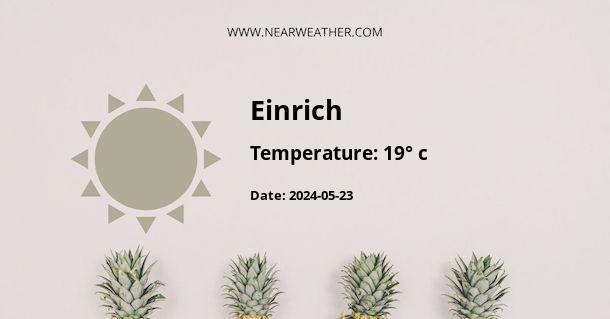Understanding the Climate and Weather Patterns of Einrich, Germany
The climate in Einrich, Germany, as with much of Central Europe, is characterized by its temperate and changing nature. Einrich's weather features distinct seasons, each bringing its own set of conditions, which makes it an interesting study in terms of meteorology and climate science. To provide a comprehensive overview, we shall delve into seasonal weather patterns, average temperatures, precipitation levels, and discuss notable weather events that have shaped the area's climate reputation.
The Four Seasons of Einrich: A Detailed Breakdown
Spring in Einrich
Spring in Einrich witnesses a transition from the cold months into more mild temperatures. The season typically kicks off in March and extends through May.
| Month | Average High (°C) | Average Low (°C) | Average Precipitation (mm) |
|---|---|---|---|
| March | 8 | 0 | 40 |
| April | 13 | 3 | 45 |
| May | 18 | 7 | 55 |
Spring weather is largely influenced by Atlantic depressions, resulting in variable weather conditions.
Summer in Einrich
Summer, spanning June to August, brings warmer conditions with increased sunshine hours and, occasionally, heatwaves.
| Month | Average High (°C) | Average Low (°C) | Average Precipitation (mm) |
|---|---|---|---|
| June | 22 | 11 | 60 |
| July | 24 | 13 | 70 |
| August | 24 | 12 | 65 |
Summer tends to be the wettest season in Einrich, with convective showers and thunderstorms being relatively common.
Autumn in Einrich
As fall arrives in September and stretches to November, temperatures begin to cool, and the landscape changes color.
| Month | Average High (°C) | Average Low (°C) | Average Precipitation (mm) |
|---|---|---|---|
| September | 19 | 9 | 45 |
| October | 13 | 5 | 55 |
| November | 7 | 1 | 50 |
The notable feature of autumn is the increased likelihood of foggy mornings due to temperature inversion, particularly noticeable in the hilly and forested areas.
Winter in Einrich
Winter, from December through to February, is the coldest season, characterized by shorter days and a greater potential for snowfall.
| Month | Average High (°C) | Average Low (°C) | Average Precipitation (mm) |
|---|---|---|---|
| December | 3 | -2 | 55 |
| January | 2 | -3 | 40 |
| February | 4 | -3 | 35 |
In this season, cold snaps can plunge temperatures well below freezing, bringing frost and snow, particularly impacting the rural outskirts.
Climate Influencers and Notable Weather Events
Einrich is subjected to a range of meteorological influences. Its proximity to the Atlantic Ocean moderates extreme temperatures, yet it isn't immune to the occasional severe weather event. As a result, climate studies indicate an increasing trend in extreme weather occurrences, such as the 2013 European floods, impacting the region significantly.
- Atlantic Influence: As fronts move in from the west, they often bring erratic weather with bouts of rain and wind, particularly during the transition seasons.
- Continental Influence: During both summer and winter, the influence of the European landmass can lead to more pronounced seasonal temperatures, ranging from hotter summers to colder winters.
- Topographical Factors: The varied terrain surrounding Einrich, including valleys and forested hills, also plays a role in microclimates that may experience different weather patterns from the general area.
Understanding Weather Patterns for Agriculturists and Tourists
For agriculturists, understanding the timing of frosts, the amount of average sunshine, and rainfall distribution is vital for crop planning and management. Tourists planning a visit to Einrich may prefer the temperate conditions of late spring or early autumn, where they can enjoy the cultural festivals without the extremes of summer heat or winter cold.
Expert Opinions and Future Predictions
Climate experts continue to monitor changes, with many predicting altering patterns as a result of global warming. These may manifest as more extreme weather events, variations in precipitation distribution, and shifts in seasonal temperatures. The city's infrastructure and planning continue to adapt to these predicted changes with investments in flood defenses and climate-resilient construction techniques.
A Year-Round Perspective
In conclusion, Einrich offers a diverse climate that serves as a template of the Central European weather system. Those living in or visiting the region can expect a four-season experience with a wealth of weather variety, from sunny, verdant springs and hot summers to golden autumns and potentially snowy winters. As the global climate evolves, so too will Einrich's weather patterns, warranting continual observation and study.
Understanding Einrich's weather and climate is not only of interest to meteorologists and climate enthusiasts but is also critical for farmers, city planners, and tourists who interact with the region in various ways. Annual weather patterns heavily influence agricultural cycles, tourism, and infrastructure planning, making this information invaluable for many stakeholders.
Weather and climate are complicated systems that are deeply intertwined with our everyday lives. Paying close attention to the climate of Einrich, Germany, helps residents and visitors alike prepare for what nature has to offer, thus fostering a harmonious relationship between humans and their environment.
A - Einrich's Latitude is 50.250000 & Longitude is 7.800000.
A - Weather in Einrich is 11° today.
A - Climate Conditions in Einrich shows clear sky today.
A - Humidity in Einrich is 55% today.
A - Wind speed in Einrich is 4.82 km/h, flowing at 102° wind direction. today.
